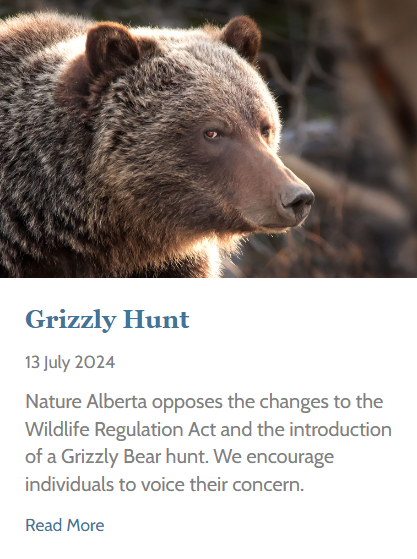Alberta’s Grizzlies Aren’t Out of the Woods
24 July 2024
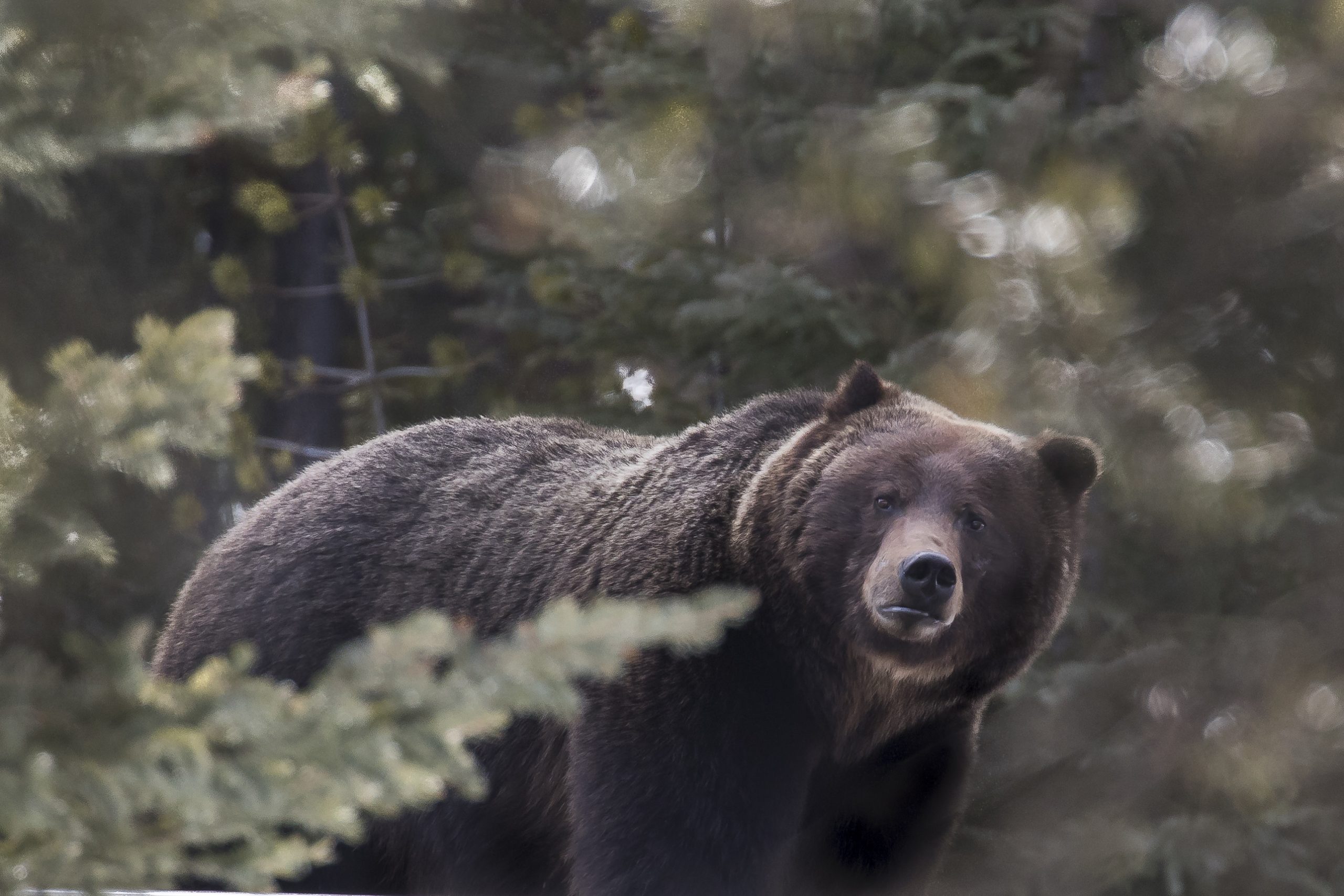
BY NICK CARTER
The grizzly bear is an icon of Alberta’s wilderness. People have looked on them with a healthy measure of fear and respect since long before Europeans arrived here. Grizzlies have had conflicts with people, in the worst cases leading to tragic loss of life for both species. However, most Albertans today remain in awe of this iconic species, and agree that there’s room for both people and grizzlies in this province.
It was to the outrage of many, then, that the Alberta government recently announced it was reinstating a grizzly bear hunt of sorts, despite concerns over the status of the species in this province. The grizzly has been classified as a Threatened species here for over a decade, and both historical and current data shows that this development isn’t going to help matters.
Natural History
The grizzly bear is a subspecies of brown bear, which has a distribution across much of the northern hemisphere. The size and appearance of this species varies depending on age and environment. In general, though, the grizzly is a large bear with a prominent shoulder hump, wide face, short snout, and small, round ears. The front claws are long, slightly curved, and pale. The coat is varying shades of brown with silver tips in adults, which give this “grizzled” bear its name. These features set them apart from the American black bear, with its long, doglike snout, lack of shoulder hump, and hooked claws. The grizzly bear is Alberta’s largest predator, with adult females generally weighing 80 to 225 kg and the larger males coming in at 250 to 350 kg.
For the past century, grizzly bears have occupied Alberta’s more remote western regions. They can be found in the foothills, valleys, and slopes of the Rocky Mountains as well as the northwest section of the province. Habitat preferences can vary, but in general grizzlies spend more time in open country compared to the forest-loving black bears. High alpine meadows, wooded hills and valleys, and open fields can be suitable for this species, as long as there’s food to be had.
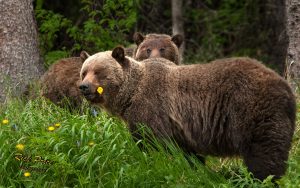
Grizzly bears are omnivores, and a much of their time from spring through fall is spent on feeding. RICK PRICE
Grizzly bears are omnivores, and like black bears much of their diet is plant-based. Berries, tubers, grasses, and nuts make up their core intake, along with insects and their larvae. Grizzlies will also consume meat when available, both from scavenging as well as hunting live prey, which they tend to do more often than black bears. Prey in Alberta includes burrowing rodents; fish; ungulates like deer, elk, caribou, and moose; and even black bears on occasion.
From spring through fall, grizzly bears spend much of their time eating in order to store enough calories for the winter denning period, during which time they mostly sleep the colder months away. The time at which they enter the den and emerge again varies depending on sex, age, and food availability, but in general adult males den later in the year and emerge sooner in the spring than females with cubs.1
Population Decline
Before the days of European colonization, grizzly bears lived across most of western North America, from northern Alaska to central Mexico to the Mississippi River.1 In what’s now Alberta, grizzlies were found throughout the entire province, including the southern prairies, where they lived alongside bison and other species of the open grasslands.
As settlement brought farms, ranches, cities, and resource extraction to the interior of the continent, grizzly bears were extirpated from much of their original range, with only populations in the more remote mountains and northern regions surviving. North of Edmonton, they now range no further east than Slave Lake, and this range narrows as the foothills hug closer to the mountain slopes southward to the U.S. border.
It was fortunate that some of the last remaining grizzly bear habitat in Alberta was preserved in the form of Jasper, Banff, and Waterton national parks, as well as a smattering of provincial parks in the mountains and foothills. In these spaces, grizzlies had at least some room to exist, and were safe from hunting. However, grizzly populations in Alberta continued to decline into the new millennium.
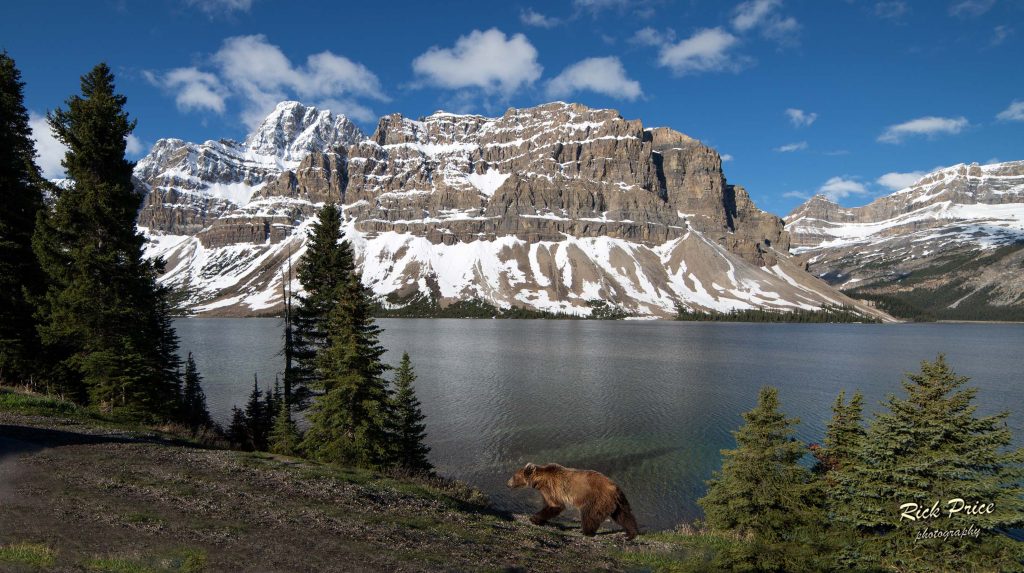
As settlers spread across western Canada, grizzly bears were extirpated from much of the grassland and parkland, surviving only in more remote areas. RICK PRICE
The two main threats to grizzlies in Alberta were, and still are, mortality directly caused by humans and habitat loss. Human-caused deaths include poaching, collisions with vehicles or trains, self-defence (people killing an attacking grizzly), and mistaken identity (black bear hunters accidentally shooting grizzlies), but up until 2006 the biggest human-caused threat was the legal sport hunting of grizzlies.2
Combined with the increasing fragmentation of habitat due to agriculture, highways, oil and gas extraction, and other developments, this has led to an increasingly perilous situation for grizzly bears in the province.
Conservation and Current Threats
In response to the situation the grizzlies were facing, in 2005 provincial government biologists advocated for the species to be classified as Threatened and recommended discontinuing the grizzly hunt in Alberta. This hunting ban occurred in 2006, and two years later a five-year recovery plan for the species was published. This plan, in summary, recommended reducing conflicts between grizzlies and humans, reducing human-caused deaths, getting a better scientific understanding of grizzly populations in Alberta, and maintaining the integrity of grizzly bear habitat.2
Based on the small population size of grizzlies in Alberta, combined with their low reproductive rate, limited immigration of individuals from outside the province, and increasing alteration of habitat, in 2010 the grizzly bear was officially designated as Threatened in Alberta under the Wildlife Act. That same year its provincial status was elevated from “May Be at Risk” to “At Risk,” and as of 2020 it has remained so.
Also in 2020, an updated grizzly recovery plan was published.3 One aspect discussed within was the population trends in divided regions of grizzly habitat managed by the government, known as Bear Management Areas (BMAs), which had been established under the previous plan. Altogether, the Alberta BMAs constitute the government’s “Recovery Zone” for grizzlies. While some BMAs saw stable or even increasing populations, others were still unassessed.
However, the plan’s analysis also found that interactions between grizzly bears and humans are still a problem, especially in human-dominated areas. This continues to be a source of mortality for grizzlies due to aforementioned factors (poaching, vehicle/train collisions, human self-defence, and mistaken identity), and these don't seem to be getting any better as more and more people seek recreation and livelihoods in grizzly bear habitat. Increased tourism in bear country leads to more roads and more vehicles. Jasper and Banff parks already have a major railway and highway running through each. Not only do highway corridors bring the threat of vehicle collisions, they also cut off bear populations from one another, leading to less gene flow.
As human settlements and agriculture continue to push into grizzly bear habitat, bears are drawn to the food sources we unintentionally provide. This often leads to grizzlies either being killed or trapped and relocated, which itself often leads to an early death for the relocated bear.
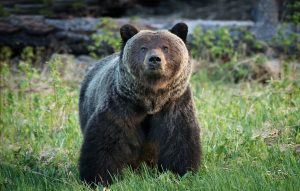
Grizzly bears are opportunistic, and their powerful sense of smell often draws them to food sources left by humans. Despite this, grizzlies tend to avoid humans whenever possible. RICK PRICE
In light of these persistent threats, the 2020 recovery plan laid out its recovery goal, which reads as follows: “The Alberta grizzly bear population in the Recovery Zone is not limited by human-caused mortality, has access to secure habitat, is able to successfully disperse across major road corridors, and Albertans — in particular those living, working and recreating in grizzly bear management zones — are supportive of grizzly bear conservation and management activities.”
While things seem to be moving in a good direction, grizzly bears are still sensitive to human-caused mortality and habitat disturbances, and remain At Risk in Alberta. If we can continue trying to preserve intact habitat and protect them from death at our hands, grizzly bears seem to have a strong hope of bouncing back in Alberta, at least within their core range.
Grizzly bears’ recovery in Alberta may be undermined, however, with the recent announcement from the Ministry of Forestry and Parks that the government would allow private citizens to shoot “problem” grizzlies. These are specific individual bears that pose a clear danger to people, often when they become habituated to human food sources or start preying on livestock and become threatening to human life and livelihood. These bears often end up needing to be relocated or, in cases of repeat offence or loss of human life, require euthanization. It’s a situation where no one wins, and to stop such conflicts from happening in the first place, the government instituted its BearSmart program.
On the rare and unfortunate occasions when the relocation or killing of a grizzly is deemed necessary, it has long been carried out strictly by highly trained government wildlife officers. Until now, that is. The rationale behind this change is flimsy and largely fear-based. A news release published by the provincial government on July 9, 2024 framed grizzly bears as an increasing menace to the lives of Albertans.4 It claims that attacks on humans are becoming more predatory in nature, but provides no data on this. While the last two grizzly bear fatalities in Alberta seem to have been predatory attacks, both involved older, malnourished bears with worn teeth.5,6 Since the 1970s, reports of fatal grizzly attacks in Alberta have ranged from one to three per year with no sign of increasing, despite the presence of more and more people in grizzly habitat each year.
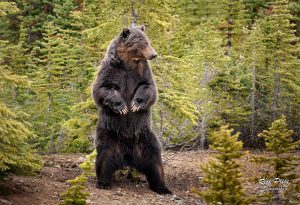
Grizzly bears are powerful and intimidating animals, but our relationship with them should be based scientific data, not fear. RICK PRICE
In spite of this, the government has announced the creation of a “network of wildlife management responders,” a group that anyone can apply to join, to destroy problem grizzlies. This raises numerous questions, such as how private citizens selected to hunt problematic bears will identify their specific targets. Given the degree to which black bear hunters mistakenly kill grizzly bears, how confident can we be that these “wildlife management responders” will consistently know their targets?
Nowhere in the Alberta Grizzly Bear Recovery Plan is euthanization by a “wildlife management responders” mentioned as a viable method of managing our grizzly population. No other Threatened species in Alberta is open for hunting by private citizens in this manner.
This plan seems ripe for exploitation and ethically unscrupulous; aspiring bear hunters may now become incentivized to behave irresponsibly in the wilderness in order to create more problem bears that they can shoot. The government news release states that this is not a bear hunt, but that’s essentially what it amounts to: an exclusive trophy hunt in the guise of wildlife management. The provincial government has confirmed that hunters will be allowed to keep the carcass.7
The decision to form this posse of grizzly bounty hunters was made with no consultation from provincial wildlife biologists. It seems the only important factor in this decision was that grizzly bears are, for now, recovering in Alberta, and because of this an increasing amount of conflicts with people arise. More humans and more bears want a piece of the western Alberta wilderness, and even though the provincial government still leans on the BearSmart program and habitat restoration, in the end it seems that our claims outweigh those of the bears.
Humans and bears have never gotten along in complete harmony, and it’s always unfortunate when our property and livelihoods are damaged by them. Worse still is when human life is lost because of a bear. This tragic situation is one that nobody wants, but responding with vengeful fear and ill-conceived persecution is not the answer. According to Minister Todd Loewen, “the loss of even one human life because of a grizzly bear attack is one too many.” But how many grizzly deaths at our hands do we consider to be unacceptable? Does their right to exist end where our priorities begin?
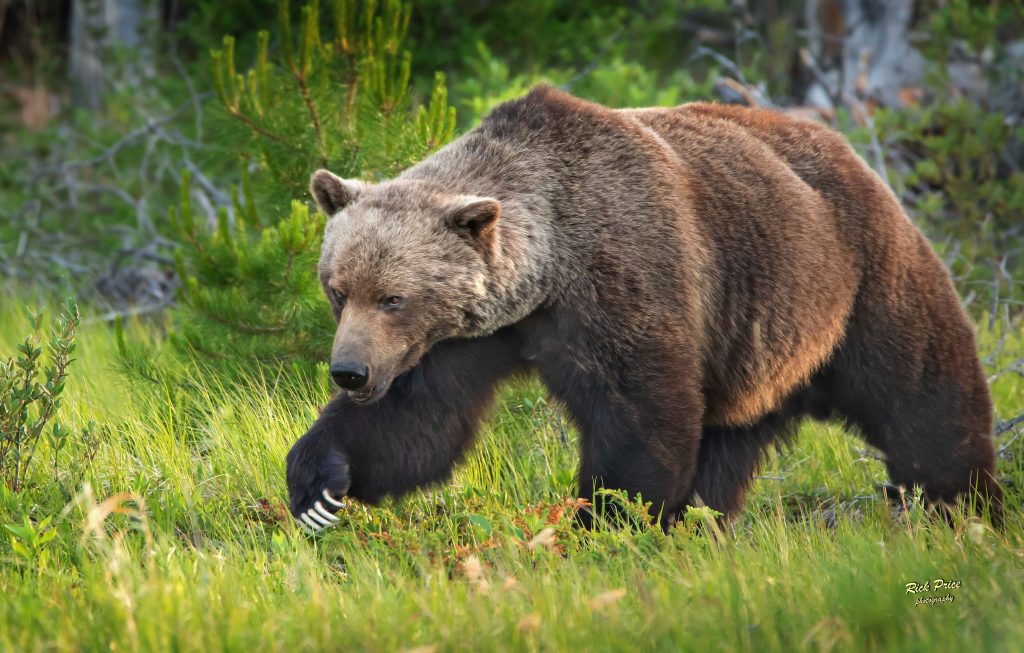
The Alberta wilderness is the home of the grizzly bear, and we should do our best to coexist with them in peace. RICK PRICE
References
- Naughton, Donna et al. The Natural History of Canadian Mammals, University of Toronto Press (2012). pp. 412-17.
- Alberta Grizzly Bear Recovery Plan 2008-2013 (2008). Alberta Sustainable Resource Development, Fish and Wildlife Division, Alberta Species at Risk Recovery Plan No. 15. Edmonton, AB. 68 pp.
- Alberta Environment and Parks (2020). Alberta Grizzly Bear Recovery Plan. Alberta Species at Risk Recovery Plan No. 37. Edmonton, AB. 84 pp.
- Alberta Government News. https://www.alberta.ca/release.cfm?xID=90627FA92D516-F852-9BAF-A462F6C3D44224AC
- "Backcountry campers killed by bear in Banff National Park were on multi-day trip, family says." CBC News. October 30, 2023. https://www.cbc.ca/news/canada/calgary/bear-attack-parks-canada-1.6985580. Accessed July 22, 2024.
- “Grizzly believed to have killed Alberta woman captured, euthanized." Toronto Sun. May 31, 2021. https://torontosun.com/news/national/grizzly-believed-to-have-killed-alberta-woman-captured-to-be-euthanized. Accessed July 22, 2024.
- “Alberta grizzly hunters will get to keep the carcass when called on to euthanize bears.” National Post. July 13, 2024. https://nationalpost.com/news/canada/alberta-grizzly-hunters-will-get-to-keep-the-carcass-when-called-on-to-euthanize-bears. Accessed July 22, 2024.
Nick Carter is a writer, photographer, and naturalist from Edmonton. From birds and bugs to flowers and fossils, Nick is always seeking out the natural wonders of this province and sharing his enthusiasm with others.

